It’s Pie Season! Do yourself a favor and bookmark this perfectly flaky grain- and gluten free pie crust recipe and you’ll be set for the holidays and beyond!
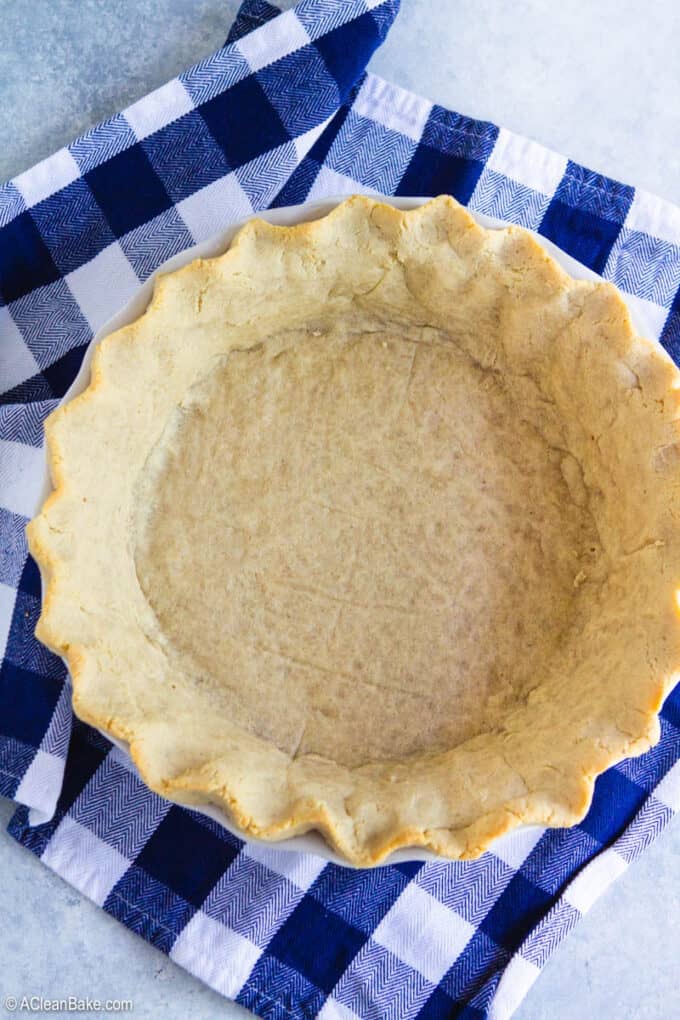
I’m hooked on the basics.
That is to say, I’ve recently become (more) obsessed with perfecting gluten- and grain-free dessert staples so that you can always find what you need to make the end of your meal everything you wanted and more.
One major blind spot on this site (and in my life) has always been pie. A long, long time ago, I created a paleo and gluten free pie crust recipe – and despite much tweaking over the subsequent years, it never quiiiiite satisfied me.
Don’t get me wrong: it wasn’t bad, and plenty of people have messaged me saying they love it. But it is decidedly low carb – made from almond flour, coconut flour, and stevia, with none of the starch or sugar that makes a pie crust the crisp-outside, soft-and-flaky-inside masterpiece you want to nestle your apples or banana pudding or brunchy eggs in. My husband has tried it several times, but keeps exclaiming “this is grain free?? Reeeeally????” every time he takes a bite!
That one isn’t going anywhere. It’s still on the site, more accurately named as a low carb pie crust, for you to enjoy if you want to.
But if you are open to a new, nearly-flawless gluten free and paleo pie crust recipe to go back to again and again (particularly as we are entering pie season!), sit down and stay awhile. We have a lot to talk about.

What does it take to make the best paleo and gf pie crust out there?
Luckily, not much. Gluten-based pie crust would make the same claim, but we all know that’s not true: you have to work quickly, touch it gently, not overwork the gluten (which makes for tough, rather than delicate, crust), keep ingredients, surfaces, your pie plate, and your hands cold, then chill it for a couple of hours before baking.
Pfffft.
Ain’t nobody got time for that.
I’ve tested this one million times and no you don’t need cold hands, a cool marble board, time in the fridge, or any of that fussiness.
All you need is:
- a gluten free flour mix of almond flour and cassava flour
- a pinch of salt
- an egg (this helps bind the crust together; otherwise, without gluten, it is prone to crumbling)
- cold butter (just straight from the fridge or freezer, no extra planning necessary)
- cold water (from your fridge, or tap water with some ice in it)(but don’t add the ice to the crust!)
That’s right: just 6 ingredients.
Ok, fine, but what about equipment?
Yes, that’s a good question. But, considering how simple and straightforward the ingredients are, do you think I would stand for a fussy, difficult process full of strange equipment?
Nahhh. You literally make this crust by throwing all of the dry ingredients into a food processor, pulsing a few times, adding the wet ingredients, and pressing it into a pie pan. That’s it. You don’t even have to break out your rolling pin (more on that in a minute).

Getting the Crust into the Pan
Since this recipe doesn’t contain gluten or an ingredient like xanthan gum that is often used in gluten free baking to mimic the gluten’s structural role, the dough will not be as pliable as conventional pie dough.
So, a conventional pie crust recipe would call for you to turn the mixed dough out onto a board and roll it out, then transfer it to the pan. You can do this, but be prepared for the dough to crack and break during the transfer from your board to your pie plate.
Instead, I recommend turning your dough straight from the food processor into a lightly-greased pie plate, and using the heel of your hand to work it into the pan and up the sides.
To do this successfully, you’ll need to cover your hands, which prevents sticking and allows you to work quickly (remember, the heat of your hand will start to melt the butter in the dough, so you want to minimize contact as much as possible).
My strategy is to cut a piece of plastic wrap about the size of my hand and place that between the crust and my hand, so my skin never actually touches the crust. You could also dust your hand with arrowroot or tapioca flour. To be clear, this doesn’t reduce the effect of the heat of your hands, but it does prevent stickiness and mess, so you can work faster – i.e. you’re touching the crust less.
Double Crust Pies
I’ll bet I know your next question: if this crust doesn’t roll and transfer well, what about a double-crust pie? Well it does roll out really well, actually. It’s just the transferring of the top crust onto the pie that is potentially problematic. I tend to stick to single-crust pies with a crumble topping (like this show-stopping apple pie!) or do a lattice or cutout crust.
But if you want to do a full top crust you’ll need to work carefully, and perhaps enlist a family member or a pizza peel to help support the crust during the transfer. You’ll probably still encounter a few cracks or breaks; those are easy to fix with your fingertips. If you’re having trouble, use a few drops of cold water to help glue the crust back together.
Either way, the last step is going to be crimping the edges. Any dough that has fallen off during transfer and you don’t need for patching can be adhered to the edges and crimped in. To crimp the crust, place your index finger behind the edge, and use the thumb and index finger of your other hand to slice the edge back so it curls around your index finger. Repeat all the way around your crust.
Let’s Talk about Blind Baking
There are two important steps that will ensure that this pie crust recipe is a success. The first is blind baking.
Blind baking – or, pre-baking the crust for a short amount of time before it is filled – is really critical to a successful pie recipe. Do not skip this step, as fussy as it may seem, or you’ll risk raw or soggy bottomed pie crust!
Everyone knows a soggy bottom crust is a high baking crime.
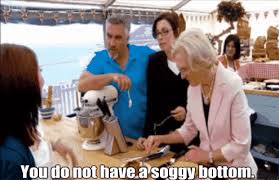
Don’t panic; blind baking is easy to do. Once you’ve pressed your crust into the prepared pie plate, you will cover it completely with a large piece of parchment paper, and then fill the pie, on top of the parchment, with pie weights.
Pie weights are nothing more than small, heavy-for-their-size, oven-safe balls, roughly the size of marbles, that counterweight any air bubbles that would otherwise expand in the oven and cause the pie crust to become uneven. Basically, they make sure the crust bakes flat.
You can buy pie weights at kitchen supply stores, but dry beans work just as well for a fraction of the cost. I have used a $1 bag of dry pinto beans as pie weights over and over for years! Once you use a bag of beans as pie weights, you can’t eat them. Just cool them and store in an airtight container until your next pie.
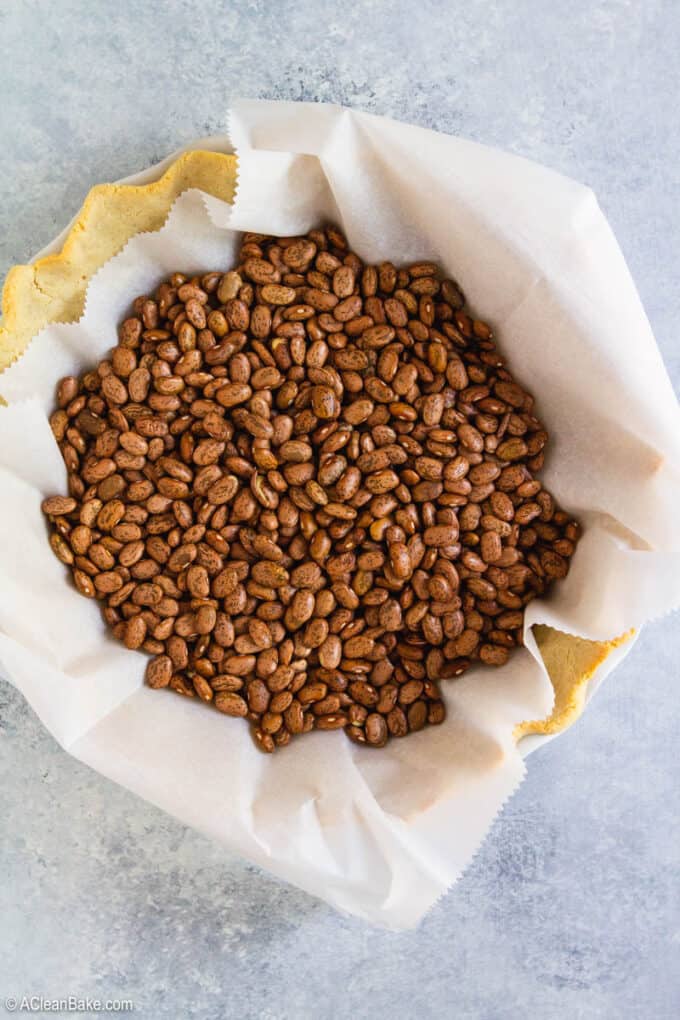
Tips for Gluten Free Pie Crust Success
Please read through this section before you make any substitutions in the recipe! I will address most of the common questions I get on recipes.
Flour
I often get questions about replacing the flour or dry ingredients. Do not replace the gluten free flour blend called for in the recipe with a gluten free all purpose flour. That will dramatically change the way the crust comes out, probably not in a way you’ll be happy with.
You can use your preferred brands of flour, but make sure you’re using an ultra-fine-milled product. I recommend Honeyville or Bob’s Red Mill brand almond flour, and Otto’s Naturals Cassava Flour.
Butter (or, How to Make This Dairy Free and Vegan)
The good news is that it is easy to make this recipe dairy free. You can replace the butter (unsalted butter, please, if you’re new to me preaching about butter in baking!) with coconut oil. If you’re using coconut oil, you can use room temperature (soft) oil, since it’s so much more difficult to work with when it’s chilled. However, you will end up with a sliiiiiightly less flaky crust.
You can also try replacing the butter with cold palm shortening, if that’s something you use. I have not tried it, but as long as you keep it very cold, it should yield a pleasant crust.
The question of how to make this crust vegan is a little bit trickier, because, in the absence of gluten (and, as I said earlier, gluten subs like xanthan gum), the eggs play a vital role in binding the crust together and preventing it from crumbling when you cut the finished pie. I have not tested this recipe without eggs or with egg substitutes, so I would recommend using this recipe instead if you’re looking for a vegan pie crust.
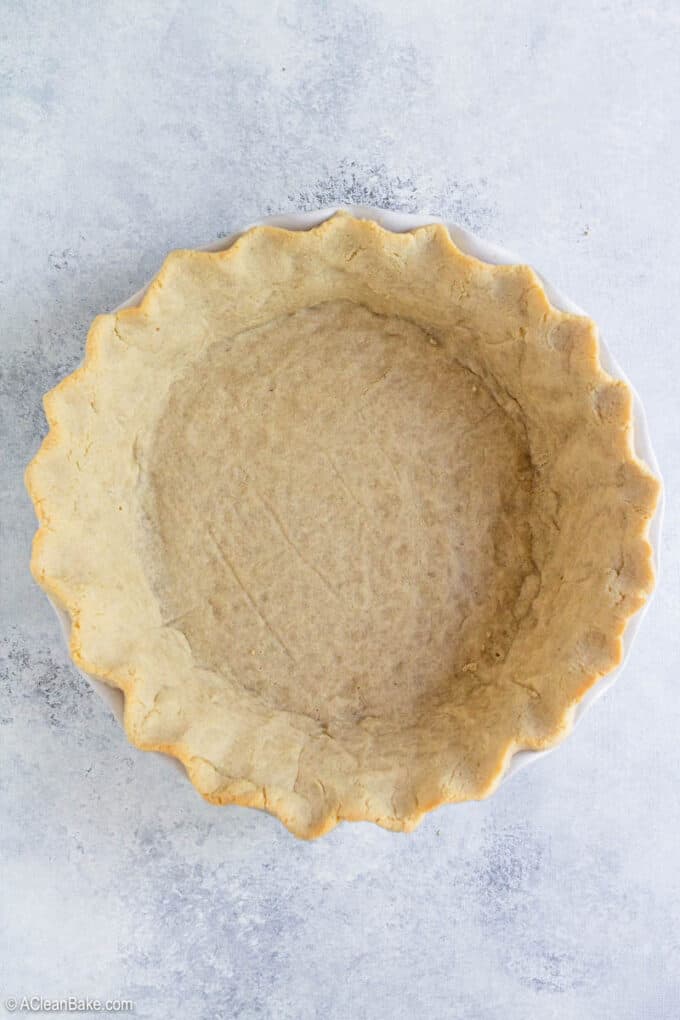
Double Crust Pies
If you’d like to make a double-crust pie, simple double this recipe and see all of my advice and discussion above.
Sweet vs Savory Gluten Free Crust
I use this crust recipe for everything from apple pie, pecan pie, and pumpkin pie (I told you it was pie season!) to quiche and pot pie for easy comfort meals.
However, you may be accustomed to a sweeter crust. So, you can add 6 tablespoons maple sugar or 1/4 cup granulated stevia or monk fruit (or to taste) along with the rest of the dry ingredients. And, for sweet, do not remove the 1/4 teaspoon salt – rather than make it salty, it enhances the sweetness.
But, as I said, this version as written will work for sweet or savory applications.
Over-Browning
Like wheat-based crusts, this one has a tendency to over-cook around the delicate edges before the filling is completely cooked or set. To avoid this, check about halfway through cooking to confirm that the exposed crust is a light golden brown. If it is, loosely cover the exposed crust with an oven-safe crust shield, or strips of aluminum foil to slow the rate of cooking.
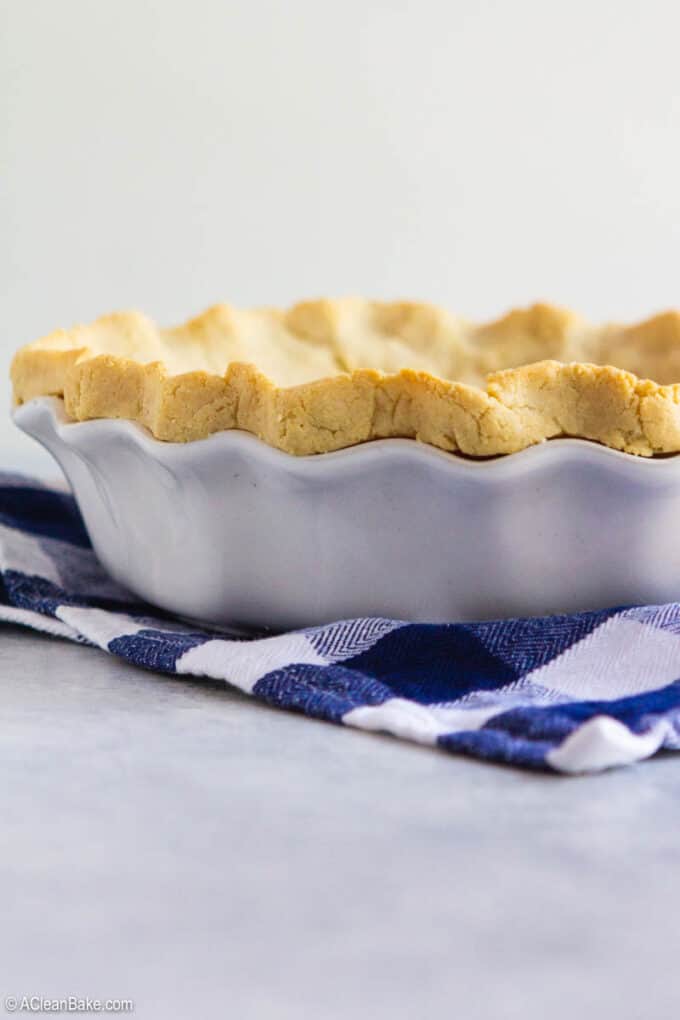
The Best Gluten Free Pie Crust You’ll Eat!
Golden brown and buttery, this flaky gluten free pie crust is just as good as the the wheat flour version!
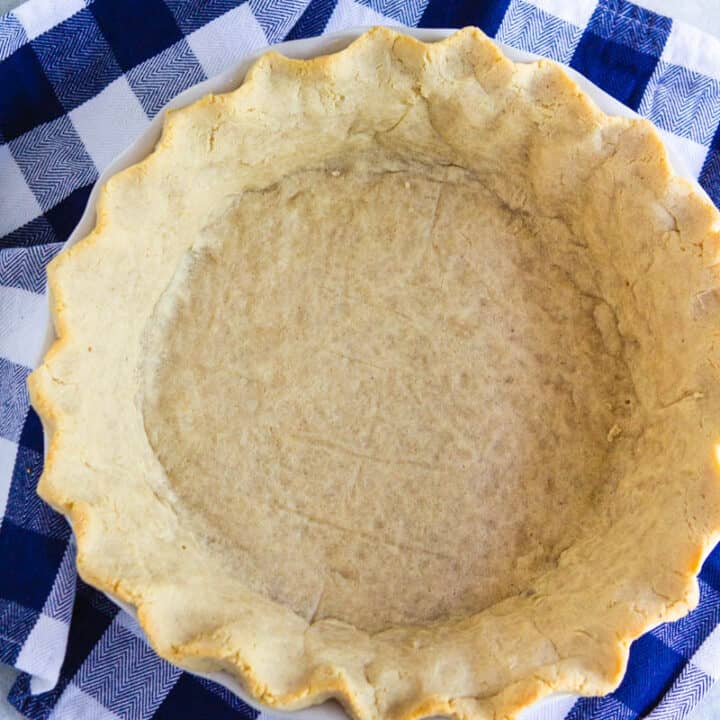
Grain Free and Gluten Free Pie Crust
Do yourself a favor and bookmark this perfectly flaky grain- and gluten free pie crust recipe and you'll be set for the holidays and beyond!
Ingredients
- 2 cups blanched almond flour
- 1/2 cup cassava flour
- Heaping 1/4 teaspoon fine sea salt
- 1 large egg
- 1/4 cup cold butter or shortening, cut into small cubes
- 3-5 Tablespoons ice cold water
Instructions
- Preheat the oven to 350 degrees. Lightly grease a pie plate and set aside.
- In the bowl of a food processor, pulse together the almond flour, cassava flour, sweetener (if using), and salt.
- Add the egg and mix until combined.
- Add the butter and pulse until it's roughly the size of peas.
- Add the water, one tablespoon at a time, until the dough comes together. You may not need all of it (see note).
- Gather the dough into a ball and place between two pieces of parchment paper.
- Roll out into a thick disc, then transfer to the prepared pie plate and use the heel of your hand to press the dough up the sides of the pan. Crimp the edges between your thumb and first two fingers.
- Place one piece of parchment over the crust, and fill will pie weights or dry beans.
- Bake for 10 minutes, then remove the pie weights and parchment, and bake an additional 5 minutes.
Notes
- Use just enough water to bring the dough together in the food processor, but not more. The dough should be pliable, but not wet or excessively sticky.
- The dough is much more delicate than gluten-based dough, so transfer it to the pan very carefully and don't be concerned if it breaks. Thankfully, it can be fixed just as easily. Just press the dough back together to seal it, and dampen your fingers if you need some help getting rid of the seams.
- If you plan to store the dough in the fridge or freezer for more than an hour, add as many tablespoons of water as it takes to bring the dough together, and then add one additional tablespoon.
- For a sweet crust, you can add 6 tablespoons maple sugar or 1/4 cup granulated stevia or monk fruit along with the rest of the dry ingredients. However, I use the unsweetened version of the crust for both sweet and savory pies, so it's up to you!
Nutrition Information:
Yield: 8 Serving Size: 1Amount Per Serving: Calories: 250Total Fat: 20gSaturated Fat: 5gTrans Fat: 0gUnsaturated Fat: 14gCholesterol: 39mgSodium: 125mgCarbohydrates: 13gFiber: 4gSugar: 2gProtein: 7g
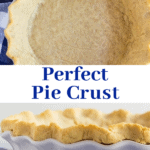
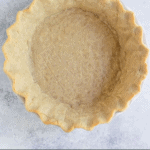
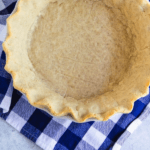

Toni says
Hi Nora! Happy full-steam-ahead baking season! By far, this has been one of your best posts……this baking issue has been elusively for me, and now I have finally been given the right education on the perfect GF pie dough! Sweet AND savory! You’re the best! Thank you so very, very much for such a great tutorial with perfect detail and instruction! Blessings!
Nora (A Clean Bake) says
Hi Toni! Thanks so much for your note. I loved your feedback!
Marita Petricic says
Hii! Is it better to use arowroot flour or tapioca flour instead of the cassava? I also have coconut flour but don’f prefer it haha
Nora (A Clean Bake) says
I wouldn’t replace the cassava with anything else, since they all absorb moisture slightly differently. Sorry!
Donna says
Nora,
I am excited to use your recipe for a Thanksgiving pecan pie. Can you give some advice on how this recipe be used in a pie that does not use a prebaked crust. I understand that the short pre-baking with the beans is required, but would you then afterwards fill your pie crust with the pecan filling and bake as usual? Thanks!
Nora (A Clean Bake) says
Hi Donna! I have never used this crust for pecan pie, but I believe it should work like any other pie. Do the 10 min pre-bake, then fill and bake as the recipe dictates. Be careful of the exposed crust burning, though. You may want to cover it with tinfoil and then remove it for the last 10-20 minutes baking time so it will brown up. Good luck! I’d love to see a picture of the finished pie! (nora@acleanbake.com)
Rachel says
Is it possible to somehow prepare this dough/crust ahead of time for travel either by refrigeration or freezing. Heading out of town Wed. morning (a couple hrs drive) and would like to bake the pie Thanksgiving Day, but have the dough or crust prepared on Tuesday night. Is that possible?
Nora (A Clean Bake) says
Yes! Complete all the steps through pre-baking. Then cool completely and wrap tightly in plastic wrap and store the wrapped pie in a zip top bag. Freeze until you’re ready to use. Or, since you want to make it the night before, you can just leave it out, loosely covered with a dinner plate or tinfoil. It doesn’t get stale easily!
Vita says
Hi, I just came across your site, and have been searching for a gf pie crust. I was wondering if I can replace the cassava flour for coconut or arrowroot flour? Thank you for a great post!
Nora (A Clean Bake) says
Arrowroot is the closest sub – but cassava is best!
Czefrah says
If making a Double Crust Pie ,how long should I bake the pie after doing the Blind Baking ?
Nora (A Clean Bake) says
Depends on the filling. Please email me for more assistance!
Siba says
Can I use extra almond flour instead of Cassava? I couldn’t find it in store and I need to make this tonight.
I also have rice flour and tapioca flour handy..
Thanks 🙂
Nora (A Clean Bake) says
Do you have coconut flour? If so you can try:
1 1/2 cups blanched almond flour
1/4 cup + 2 Tablespoons coconut flour
4 Tablespoons maple or coconut sugar (for a sweet crust)
Pinch salt
1 egg white
2 Tablespoons cold almond milk or water
1/4 cup cold butter or dairy-free (vegan) butter
Follow the same food processor method as described above.
Katie Hawkinson says
Hi Nora! So excited to hear about this recipe from my sister Ellie of Hungry by Nature 🙂 Question: I’m hoping to try this recipe as a double crust with a strawberry-rhubarb filling. I suspect that blind baking the bottom crust would be beneficial for a pretty moist filling…but how would you recommend that I go about that with the double crust? I’d love to hear your thoughts – thanks in advance!
Nora (A Clean Bake) says
Hi Katie!! I would definitely recommend blind baking for at least 10 minutes. You may also want to try an egg wash on the bottom before blind baking to help seal up the bottom crust (bake with beans or pie weights about 5 min then remove and blind bake with an egg wash on the bottom for 5-10 min more). I will admit that I haven’t tried a double crust pie with such a wet filling but I think if you do the 10-15 min blind bake plus the egg wash, that’s the most prepared you can be 🙂 Let me know if you have any other questions!
Andrea Kilgore says
What if I don’t have a food processor?
Nora (A Clean Bake) says
You can mix by hand. Just make sure everything is well-incorporated. It helps to use a pastry cutter if you have one.
Kathy Shechter says
I am doing a galette so what changes? I can’t blind bake right?any suggestions? Thanks!
Nora (A Clean Bake) says
Here are galette instructions! https://acleanbake.com/paleo-peach-galette/
Joyce says
Do you have a gluten free, nut free pie crust recipe?
Nora (A Clean Bake) says
No, I’m sorry!
Jana says
Hi Nora! I was wondering if I could omit almond flour in this recipe and use all cassava instead? Or do you have a nut-free version? Thank you!
Nora (A Clean Bake) says
I’m sorry but I wouldn’t recommend all cassava flour, because the crust will be far too dry! I’m sorry it isn’t easy to make nut-free.
Mike says
We’ve been looking for a gluten free pastry recipe for a few months and after many not so many clever attempts we have found yours to be the very best. Also we live just over 8000 feet and found an extra 1/2 tablespoon of the water and blind baking it at 365F in convection oven produced the best results. Many thanks, Mike
Nora (A Clean Bake) says
Thank you! I appreciate you sharing your method because I am often asked for high-altitude conversions and that is not my area of expertise.
Kristen says
Hi, what can I use if I don’t have pie weights or dried beans?
Aloha
Nora (A Clean Bake) says
Hi! You can skip the beans or pie weights but your pie crust might bubble up a little bit. It’s not the end of the world!
TheFlowersPoint says
Very infomative